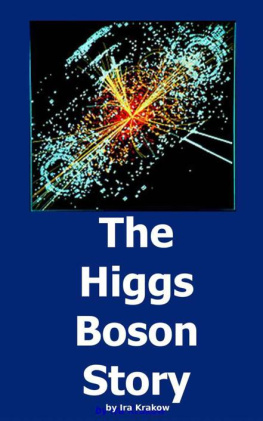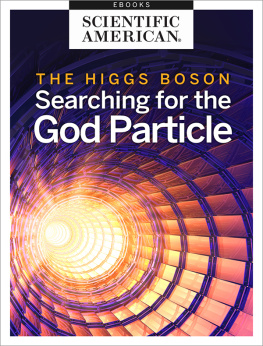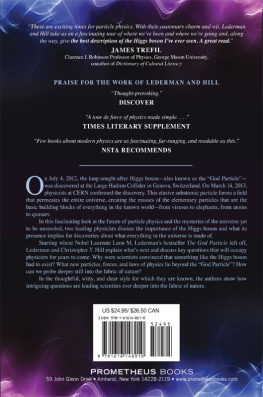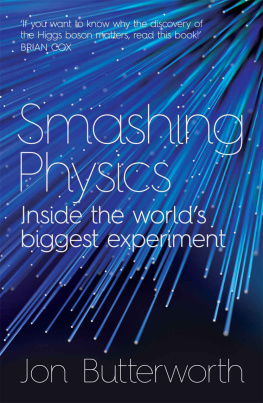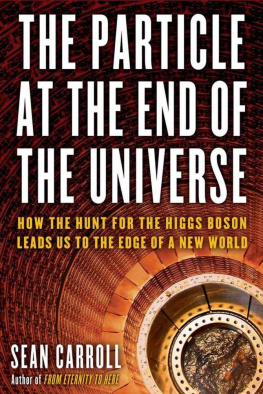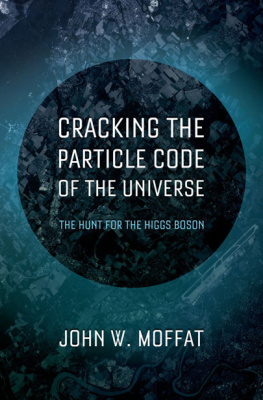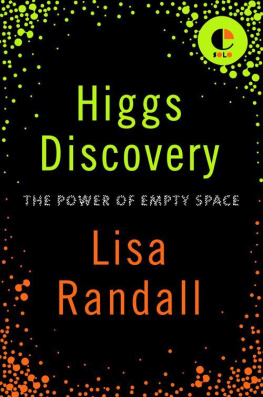Ira Krakow - The Higgs Boson Story
Here you can read online Ira Krakow - The Higgs Boson Story full text of the book (entire story) in english for free. Download pdf and epub, get meaning, cover and reviews about this ebook. year: 2011, publisher: The Krakow Press, genre: Romance novel. Description of the work, (preface) as well as reviews are available. Best literature library LitArk.com created for fans of good reading and offers a wide selection of genres:
Romance novel
Science fiction
Adventure
Detective
Science
History
Home and family
Prose
Art
Politics
Computer
Non-fiction
Religion
Business
Children
Humor
Choose a favorite category and find really read worthwhile books. Enjoy immersion in the world of imagination, feel the emotions of the characters or learn something new for yourself, make an fascinating discovery.
- Book:The Higgs Boson Story
- Author:
- Publisher:The Krakow Press
- Genre:
- Year:2011
- Rating:4 / 5
- Favourites:Add to favourites
- Your mark:
- 80
- 1
- 2
- 3
- 4
- 5
The Higgs Boson Story: summary, description and annotation
We offer to read an annotation, description, summary or preface (depends on what the author of the book "The Higgs Boson Story" wrote himself). If you haven't found the necessary information about the book — write in the comments, we will try to find it.
The Higgs Boson Story — read online for free the complete book (whole text) full work
Below is the text of the book, divided by pages. System saving the place of the last page read, allows you to conveniently read the book "The Higgs Boson Story" online for free, without having to search again every time where you left off. Put a bookmark, and you can go to the page where you finished reading at any time.
Font size:
Interval:
Bookmark:
The Higgs Boson Story
The Higgs boson , nicknamed the God particle , [1] is a hypothetical massive elementary particle that is predicted to exist by the Standard Model (SM) of particle physics . The Higgs boson is an integral part of the theoretical Higgs mechanism . If shown to exist, it would help explain why other particles can have mass . [Note 2] It is the only predicted elementary particle that has not yet been observed in particle physics experiments . [2] Theories that do not need the Higgs boson also exist and would be considered if the existence of the Higgs boson were ruled out. They are described as Higgsless models .
If shown to exist, the Higgs mechanism would also explain why the W and Z bosons , which mediate weak interactions , are massive whereas the related photon , which mediates electromagnetism, is massless. The Higgs boson is expected to be in a class of particles known as scalar bosons . ( Bosons are particles with integer spin , and scalar bosons have spin 0.)
Experiments attempting to find the particle are currently being performed using the Large Hadron Collider (LHC) at CERN , and were performed at Fermilab's Tevatron until its closure in late 2011. Some theories suggest that any mechanism capable of generating the masses of elementary particles must become visible at energies above 1.4 TeV ; [3] therefore, the LHC (colliding two 3.5 TeV beams) is expected to be able to provide experimental evidence of the existence or non-existence of the Higgs boson. [4]
On 12 December 2011, the ATLAS collaboration at the LHC found that a Higgs mass in the range from 145 to 206 GeV was excluded at the 95% confidence level. [5] On 13 December 2011, experimental results were announced from the ATLAS and CMS experiments, suggesting that if the Higgs boson exists, it is probably limited to a range of 115130GeV at the 3.6 sigma level (ATLAS) or 117127GeV at the 2.6 sigma level (CMS), and indicating possible scope for a 124 GeV (CMS) or 125-126GeV (ATLAS) Higgs. As of 13 December 2011, a joint estimate is not available. [6] [7] [8] [9]
Origin of the theory
See also: 1964 PRL symmetry breaking papers
| Wikinews has related news: Prospective Nobel Prize for Higgs boson work disputed |


Five of the six 2010 APS J.J. Sakurai Prize winners. From left to right: Kibble , Guralnik , Hagen , Englert , and Brout .


The sixth of the 2010 APS J.J. Sakurai Prize winners: Peter Higgs 2009
The Higgs mechanism is a process by which vector bosons can get a mass. It was proposed in 1964 independently and almost simultaneously by three groups of physicists: Franois Englert and Robert Brout ; [10] by Peter Higgs [11] (inspired by ideas of Philip Anderson [12] ); and by Gerald Guralnik , C. R. Hagen , and Tom Kibble . [13]
The three papers written on this discovery were each recognized as milestone papers during Physical Review Letters 's 50th anniversary celebration. [14] While each of these famous papers took similar approaches, the contributions and differences between the 1964 PRL symmetry breaking papers are noteworthy. These six physicists were also awarded the 2010 J. J. Sakurai Prize for Theoretical Particle Physics for this work. [15]
The 1964 PRL papers by Higgs and by Guralnik, Hagen, and Kibble (GHK) both displayed equations for the field that would eventually become known as the Higgs boson. In the paper by Higgs the boson is massive, and in a closing sentence Higgs writes that "an essential feature" of the theory "is the prediction of incomplete multiplets of scalar and vector bosons". In the model described in the GHK paper the boson is massless and decoupled from the massive states. In recent reviews of the topic, Guralnik states that in the GHK model the boson is massless only in a lowest-order approximation, but it is not subject to any constraint and it acquires mass at higher orders. Additionally, he states that the GHK paper was the only one to show that there are no massless Nambu-Goldstone bosons in the model and to give a complete analysis of the general Higgs mechanism . [16] [17] Following the publication of the 1964 PRL papers, the properties of the model were further discussed by Guralnik in 1965 and by Higgs in 1966 . [18] [19]
Steven Weinberg and Abdus Salam were the first to apply the Higgs mechanism to the electroweak symmetry breaking . The Higgs mechanism not only explains how the electroweak vector bosons get a mass, but predicts the ratio between the W boson and Z boson masses as well as their couplings with each other and with the Standard Model quarks and leptons. Many of these predictions have been verified by precise measurements performed at the LEP and the SLC colliders, thus confirming that the Higgs mechanism takes place in nature. [20]
The Higgs boson's existence is not a strictly necessary consequence of the Higgs mechanism: the Higgs boson exists in some but not all theories which use the Higgs mechanism. For example, the Higgs boson exists in the Standard Model and the Minimal Supersymmetric Standard Model yet is not expected to exist in Higgsless models , such as Technicolor . A goal of the LHC and Tevatron experiments is to distinguish among these models and determine if the Higgs boson exists or not.
Theoretical overview


A one-loop Feynman diagram of the first-order correction to the Higgs mass. The Higgs boson couples strongly to the top quark so it might decay into topanti-top quark pairs if it were heavy enough.
The Higgs boson particle is the quantum of the theoretical Higgs field . In empty space, the Higgs field has an amplitude different from zero; i.e. a non-zero vacuum expectation value . The existence of this non-zero vacuum expectation plays a fundamental role; it gives mass to every elementary particle that couples to the Higgs field, including the Higgs boson itself. The acquisition of a non-zero vacuum expectation value spontaneously breaks electroweak gauge symmetry . This is the Higgs mechanism, which is the simplest process capable of giving mass to the gauge bosons while remaining compatible with gauge theories . This field is analogous to a pool of molasses that "sticks" to the otherwise massless fundamental particles that travel through the field, converting them into particles with mass that form (for example) the components of atoms.
In the Standard Model, the Higgs field consists of two neutral and two charged component fields . Both of the charged components and one of the neutral fields are Goldstone bosons , which act as the longitudinal third-polarization components of the massive W + , W, and Z bosons. The quantum of the remaining neutral component corresponds to the massive Higgs boson. Since the Higgs field is a scalar field , the Higgs boson has no spin , hence no intrinsic angular momentum . The Higgs boson is also its own antiparticle and is CP-even .
Next pageFont size:
Interval:
Bookmark:
Similar books «The Higgs Boson Story»
Look at similar books to The Higgs Boson Story. We have selected literature similar in name and meaning in the hope of providing readers with more options to find new, interesting, not yet read works.
Discussion, reviews of the book The Higgs Boson Story and just readers' own opinions. Leave your comments, write what you think about the work, its meaning or the main characters. Specify what exactly you liked and what you didn't like, and why you think so.

